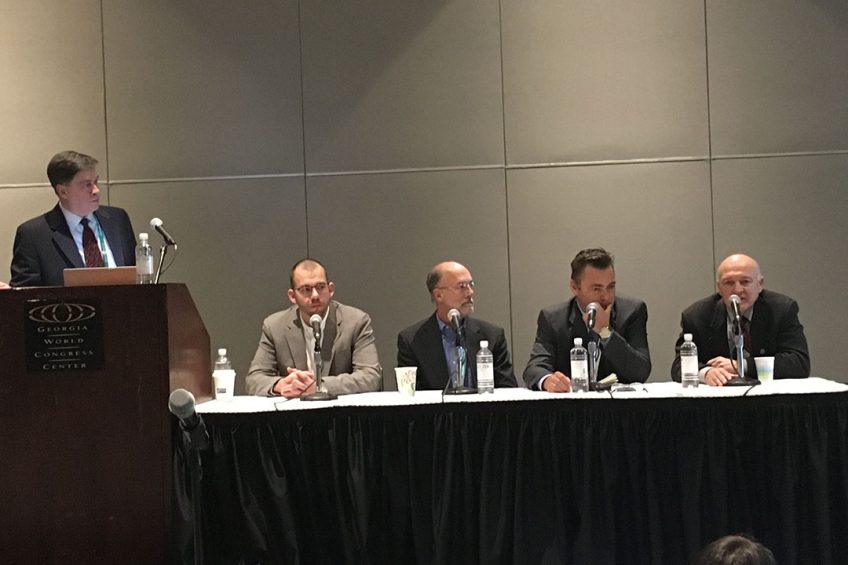Market drives NAE trend

The market for poultry meat produced with ‘No antibiotics ever’ is a self-fulfilling prophecy. Producers produce it and consumers want it. The US is at the forefront where the flywheel effect of NAE is taking off. On farm it is not always easy, attention to detail and improved animal husbandry is needed.
A panel of 4 industry experts recently discussed the current state of poultry production without antibiotics. Organised by feed additive company Perstorp, Professor Chuck Hofacre, executive vice president in the American Association Avian Pathologists, Everton Krabbe of the Brazilian agricultural research corporation (Embrapa), Sam Rochell, assistant professor at the university of Arkansas and Phillip Smith, nutritionist at Tyson Foods sat together to crack the code of ‘No antibiotics ever’ production. All the experts see the industry moving towards a more responsible use of antibiotics autonomously, but since 2015 there is great pressure on producers to move to no antibiotics fast. Professor Hofacre: “The biggest challenge is committing to NAE and the fact that it is not always voluntary. The market demand is there, so many producers are rushed into it.” By now about 50% of domestic poultry production in the US is NAE. According to Prof Hofacre the pace is set by the purchasers of meat, not the producers. “The trend will continue and NAE will become the norm for US producers.”
Challenges
The US is not the only nation moving towards NAE, Brazil is following suit. “Actually, some Brazilian producers already moved away from antibiotics about 15 years ago, but that wasn’t main stream. Since this year (2019) there is legislation in place that bans the use of antibiotic growth promoters, that will speed up NAE production as well,” states Everton Krabbe. However, the industry specialist sees challenges too: “Even with good biosecurity we see losses amounting to 2% extra mortality and a loss of 2 to 3 points in feed conversion.” This is underwritten by Tyson nutritionist Mr Smith: “Since 2015 we made a huge leap, which to be honest caused some serious problems with necrotic enteritis, coccidiosis and led to more downtime between flocks. With antibiotics we could restock our farms within days, but without antibiotics experiences teach us that a downtime between flocks of two weeks is ideal. This lowers disease pressure of the house and ensures a good fresh start for the next flock.”
Experiences from the US show that the first flock after a transition to NAE is the most easy one. Prof Hofacre: “Residual effects of antibiotics used in the past lead to a very good flock. However, after 2 or 3 grow out periods things take a turn for the worse. It takes a few bad flocks before farms are dialled into the new situation.” Mr Smith continues: ‘’Remember that NAE in the US also means no ionofores as coccidiostats. That means we are not only not able to compensate for suboptimal conditions with antibiotics, we also have to get to grips with new coccidiosis prevention with vaccines and chemical coccidiostats. That takes time, time that the market doesn’t have.”
Keep up to date on poultry health visit Poultry World’s interactive health tool
Back to basics
According to Prof Hofacre moving to no antibiotics ever asks for a cultural shift in a company. “It is imperative for the success of the business that nutritionists, veterinarians and the farm manager are on the same page.” Mr Krabbe agrees: “Antibiotics are used to compensate for suboptimal management, lack of biosecurity and inferior feed. We don’t have to do special things to be able to do without antibiotics, we have to do the essential things.” Prof Hofacre continues: “Our industry is automated to a point that we are not paying attention enough. It is time to turn the clock back a few decades and improve our animal husbandry, we have to reinvent ourselves as farmers that know the needs of their animals. We have to make sure that all our feed pans work, we need to realise that feed changes cause stress and have a negative health effect, we have to take care that our water is clean and that the litter is as dry as possible. And we seem to have forgotten where our hatching eggs are coming from. We need to ensure clean breeder farms, a good hatching programme in the hatchery and focus on chick quality, because that is the start of our make or break process.”
Feed additives
Many producers search for feed additives that can replace antibiotics. Mr Rochell on that subject: “Feed additives have potential, but you have to set up the gut with a sound diet to start with. Your lipid source, your protein level and the coarseness of the feed all come into play. Feeding for ingredient price level is out, feeding for nutrients and composition is the new holy grail.” Prof Hofacre: “There is no one replacement for antibiotics. Combinations of additives should be tailored to region, climate, farm and even to flock level to meet the birds requirements. A focus on gut health is key, but we also have to take into account respiratory and leg health as well. We have to keep our birds sound instead of repairing problems afterwards.”













